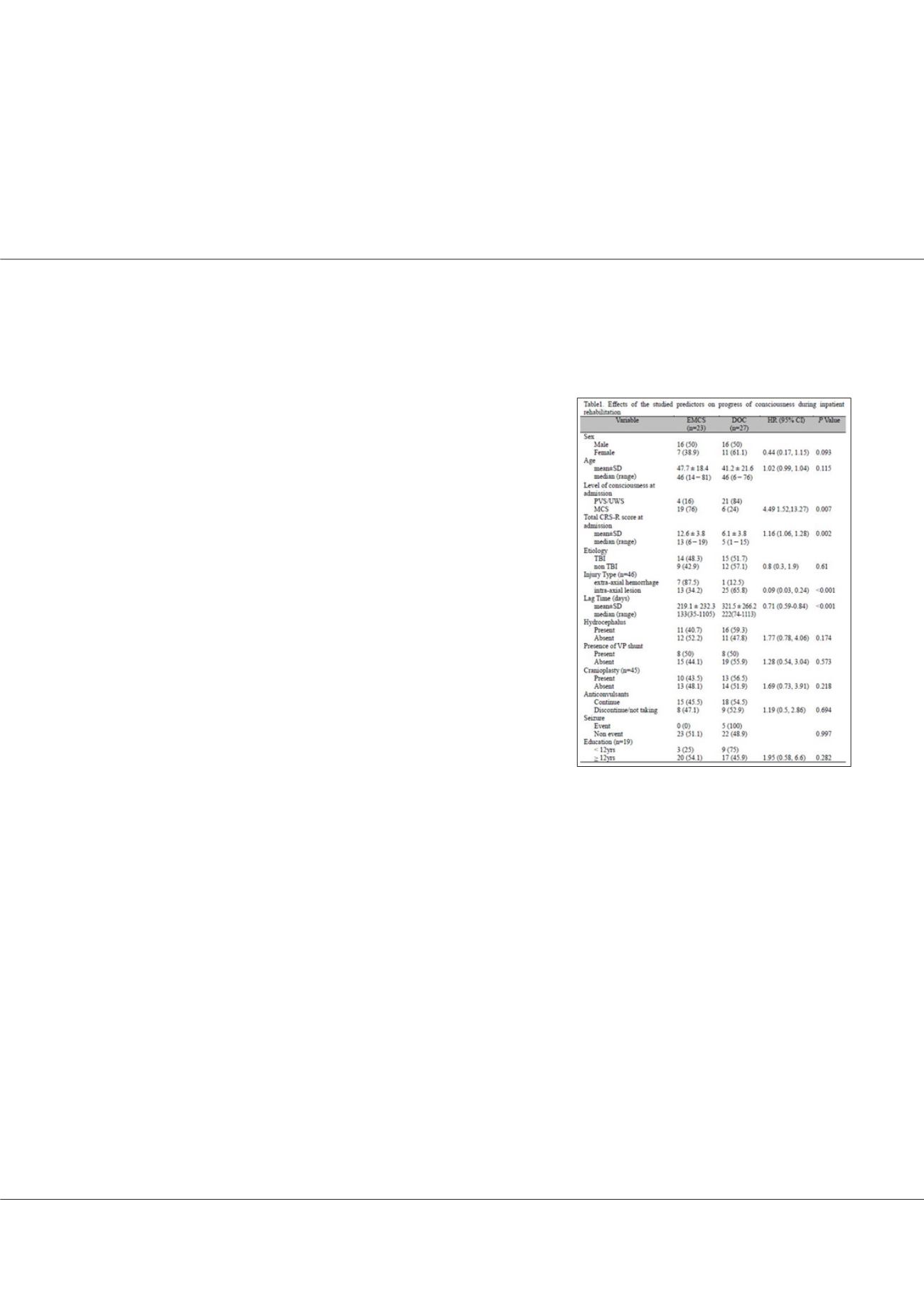

Page 35
conferenceseries
.com
Volume 20
International Journal of Emergency Mental Health & Human Resilience
World Mental Health 2018
July 16-18, 2018
July 16-18, 2018 Dubai, UAE
Public Mental Health and Neuroscience
29
th
International Conference on
Neurogenesis and functional recovery by exposure to an enriched environment in rodent models of
hypoxic-ischemic brain injury
Hoo Young Lee
The Catholic University of Korea, South Korea
Objective:
This study aimed to investigate the incidence and predictors of
emergence from prolonged disorders of consciousness (DOC) during inpatient
rehabilitation and to compare temporal dynamics and prognostic power
between six neurobehavioral signs of the JFK Coma Recovery Scale-Revised
(CRS-R) scores on emergence from DOC.
Methods:
We retrospectively collected the data of 50 patients who were
diagnosed with vegetative state(VS) or minimal state of consciousness(MCS)
at admission. Subjects were divided into two subgroups that showed emergence
fromMCS(EMCS) during neurorehabilitation and that remainedVS
orMCS.Wecompared demographic and clinical variables to investigate the best prediction
model of EMCS. Moreover, we analyzed the temporal dynamics of six CRS-R
neurobehavioral signs which were assessed at intervals of one month during the
neurorehabilitation, and identified the signs that significantly predicted EMCS.
Results:
Out of 50 patients, 46% showed EMCS. The model incorporating
shorter lag time from brain injury onset and absence of intra-axial lesion best
predicted EMCS. Also, level of consciousness and total CRS-R score at admission
individually showed significant prediction. Other variables such as sex, age at
injury onset, cause of brain injury, hydrocephalus, ventriculoperitoneal shunt,
cranioplasty, anticonvulsant medication, seizure, and education level did not
predict EMCS. Among six signs of CRS-R, auditory subscale showed the most
significant correlation to EMCS. Patients denoted slower but greater emergence
from MCS in the communication subscale than the motor subscale.
Conclusion:
This study revealed that significant recovery of consciousness is observed in patients with prolonged DOC
during neurorehabilitation. Shorter lag time and absence of intra-axial lesion were significant predictors for EMCS. Patients
in DOC with evidence of higher auditory function were most likely to recover consciousness. These findings should be
considered regarding assessment tools and rehabilitative programs that best evaluate and maximize the potential for recovery
of consciousness.
Recent Publications
1.
Lee, H. Y., Hong, J. S., Lee, K. C., Shin, Y. K., & Cho, S. R. (2015). Changes in hyolaryngeal movement and swallowing function after neuromuscular electrical stimulation in patients
with dysphagia. Annals of rehabilitation medicine, 39(2), 199-209.
2.
Lee, H. Y., Kim, S. W., & Kim, H. S (2014) Subacute Upper Abdominal Pain Diagnosed as Bilateral Diabetic Thoracic Polyradiculopathy - A Case Report. J Korean EMG
Electrodiagn Med 16(2):75~79.
3.
Kang, S. W., Choi, W. A., Won, Y. H., Lee, J. W., Lee, H. Y., & Kim, D. J. (2016). Clinical Implications of Assisted Peak Cough Flow Measured With an External Glottic Control
Device for Tracheostomy Decannulation in Patients With Neuromuscular Diseases and Cervical Spinal Cord Injuries: A Pilot Study. Archives of physical medicine and rehabilitation,
97(9), 1509-1514.
Biography
Hoo Young Lee has her expertise in neurorehabilitation for traumatic brain injury and stroke. Her subspecialty in the clinic field is neuromodulation in acquired
brain injury, cognitive rehabilitation therapy and pediatric rehabilitation. Her research areas include development of rehabilitation complexity scale in the ROK,
neuromodulation, and enriched environment in adult mouse model in the context of neurorehabilitation. She has been in years of experience in clinic, research, and
education in TBI Rehabilitation Center, National Traffic Injury Rehabilitation Hospital, Gyeonggi-do, South Korea and Department of Rehabilitation Medicine, Seoul
St. Mary’s Hospital, School of Medicine, The Catholic University of Korea, Seoul, South Korea. She in a Combined Program of Master’s and Doctoral Degrees in
Department of Medicine, The Graduate School of Yonsei University, Seoul, South Korea
raphaellapmr@gmail.comHoo Young Lee, Int J Emerg Ment Health 2018, Volume 20
DOI: 10.4172/1522-4821-C2-014
















